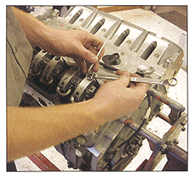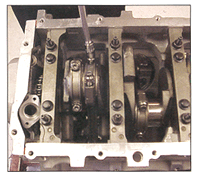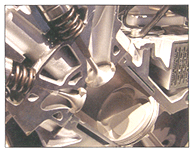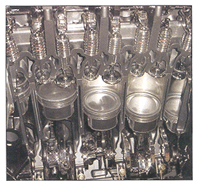It’s amazing engines last as long as they do. By the time the odometer flips past the 100,000-mile mark, most engines have turned more than 300 million revolutions! That should add up to a lot of bearing, ring and cylinder wear. Yet with proper maintenance and normal driving, many engines that reach this point show minimal wear and have many tens of thousands of miles to go. But the same isn’t always true for the upper valvetrain components.
Because the camshaft(s) only turns at half the speed of the crankshaft, the valves open and close every other revolution. Still, after 100,000 miles that’s 150 million valvetrain cycles. Even with good lubrication, heat and metal fatigue can take a toll on the valves, valve seats, guides and other valvetrain components. Nothing lasts forever.
Poor Maintenance – Poor Performance
Once the valves start to leak, the engine loses compression and doesn’t have the pep it once had. It may become harder to start. Performance and fuel economy will also suffer. Wear in the valve guides and seals may also allow an increase in oil consumption, which in turn may lead to spark plug fouling and emission problems.
If the vehicle’s owner has been lax about changing the oil and filter regularly, the bottom end can also suffer. Ring and cylinder wear increases oil consumption and blowby, which further contributes to a loss of compression and higher emissions. Increased blowby also dumps more moisture into the crankcase and causes the oil to sludge up more rapidly. If the oil change intervals are stretched out too far, this will quickly shorten the life of the bearings, rings, cylinders, crankshaft, camshaft and other moving parts. Eventually, the engine will start to make noise when it is first started. And the noise will only get worse as the miles add up.
 At some point, the customer will bring you his/her vehicle hoping you can reverse the accumulated effects of age, mileage and neglect. If your diagnosis reveals advanced engine wear or other internal problems, a “tune-up” obviously won’t help a bit. Your customer will have to face the music and invest in some major engine repairs or have you replace their engine with a new, remanufactured or used motor. The vehicle’s age, value and the customer’s ability to pay will ultimately determine which course of action makes the most economic sense.
At some point, the customer will bring you his/her vehicle hoping you can reverse the accumulated effects of age, mileage and neglect. If your diagnosis reveals advanced engine wear or other internal problems, a “tune-up” obviously won’t help a bit. Your customer will have to face the music and invest in some major engine repairs or have you replace their engine with a new, remanufactured or used motor. The vehicle’s age, value and the customer’s ability to pay will ultimately determine which course of action makes the most economic sense.
Diagnostic Hints
Any engine that burns oil is an engine that will likely need some major repairs – but not always. Continuous blue smoke in the exhaust that’s visible during all modes of driving is a sure sign of poor compression and worn or broken piston rings, worn or scored cylinders or possibly even a cracked piston. If blue smoke is only visible when decelerating, oil is being siphoned past worn valve guides. On some V8 and V6 engines, a leak in the intake manifold gasket can also draw oil into the intake ports producing smoke in the exhaust.
Sometimes an engine will use oil when there are no visible leaks or smoke in the exhaust. The oil may be getting past worn exhaust valve guides (which will leave an oily residue in the exhaust, but not on the spark plugs). Oil can also be lost through the PCV system if somebody installed the wrong replacement valve.
Reading the spark plugs will tell you a lot about the engine’s oil consumption habits. If a plug’s firing tip is covered with black oily deposits, oil is getting into the cylinder and major repairs are needed.

No compression in one cylinder almost always means a bad valve, while no compression in two adjacent cylinders almost always means a blown head gasket. No compression in any cylinder means the valves aren’t opening, probably because of a broken timing chain or belt.
Delving into Valve Work
If you’ve diagnosed a valve-related problem, the head(s) will have to be pulled so the appropriate work can be performed. Whether you decide to do the valve work yourself or farm it out to a machine shop, it’s important to remember there’s a lot more to a valve job than grinding the seats, knurling or relining the guides and replacing the valve guide seals. Valves and seats must be resurfaced with a high degree of precision so they will seal tightly and allow good heat transfer. This requires a precision valve grinder and seat machine, not a hand drill and a set of stones.
Hot, Hot, Hot!
Exhaust valves typically run at 1,200 to 1,350 F. This makes them much more vulnerable to erosion and burning than intake valves, which rarely see the high side of 800 F. Higher operating temperatures require tougher alloys, so exhaust valves are usually made of stainless steel or have stainless steel heads.
One of the reasons why you often find burned exhaust valves in high mileage engines is because the valves have gotten too hot. About 75% of the combustion heat that’s conducted away from a valve passes through the seat, so good seat contact is essential to prevent burning. The remaining 25% of the heat is dissipated up through the valve stem and out through the guides. As normal wear erodes the seats, the area of metal-to-metal between the valve and seat diminishes and reduces heat transfer from the valve to the head. The valve runs hotter and hotter and eventually cooks.
The same thing can happen if the valve seats are not cut properly when the head is redone. Too narrow a seat or a seat that isn’t concentric will reduce heat transfer and shorten the life of the valve.
 Heat also causes valves to stretch, which can lead to fatigue failure. For this reason, it’s wise to replace the exhaust valves when the heads are redone.
Heat also causes valves to stretch, which can lead to fatigue failure. For this reason, it’s wise to replace the exhaust valves when the heads are redone.
Valve Tips
Weak valve springs or insufficient valve lash can also prevent good valve-to-seat contact and allow excessive heat to build up in the valves. A loose seat or poorly fitting guide will also hinder heat transfer to the head and contribute to burning.
Not paying attention to the installed valve height when doing a valve job can also get you into trouble. When valves and seats are ground or cut, the valves sit deeper in the head than before. This causes the stems to stick up higher, which changes the rocker arm geometry and may lead to a loss of valve lash when the engine gets hot. The same condition can place excessive side loads on the valve stem, which may cause it to break off near the keeper.
If the head shows signs of valve sticking (badly worn or galled valve stems and guides), there may be a cooling problem that’s making the head run hot. Check for undetected coolant leaks (like hairline cracks or porosity leaks in the head or block), a stuck thermostat, a weak water pump, a clogged radiator, a weak fan clutch, or a defective electric cooling fan or fan switch.
When measuring valve stems, remember that most OEM valve stems are tapered. The head end of the stem is usually about .001″ smaller in diameter than the tip to compensate for increased thermal expansion in the hot end. Where the measurement is taken is very important for an accurate reading on stem wear. If the OEM valve is replaced with one that has a straight stem (not tapered), the valve may stick unless the guide clearance is opened up a corresponding amount.
Another condition that can make valves run hot is elevated combustion temperatures. Underlying causes here include retarded ignition timing, lean fuel mixtures (maybe due to a vacuum leak), detonation and preignition, and even exhaust restrictions such as a clogged catalytic converter.
 It Also Rings True
It Also Rings True
If the rings are worn, the cylinders are probably worn too and will have to be bored or honed for oversized rings and pistons. If you can feel a ridge at the top of the cylinder, measure the bore with a dial gauge to determine if boring or honing is necessary.
The “rule of thumb” used to be that up to .010″ of taper wear was considered acceptable. This is no longer the case. Tolerances in today’s engines are much tighter, and the maximum acceptable limit for taper wear in many engines is only .004″ or less. Always refer to the engine manufacturer’s specifications for maximum bore diameter and taper.
If you’re doing a ring job and discover broken rings, be sure to check for excessive taper in the cylinders. Other causes include detonation and improper ring installation (a good reason for always using a ring expander to install new rings on pistons).
It’s important to always use the same type (or better) replacement ring as the original. Many engines now have ring sets with steel or ductile iron top rings because these materials are more durable than ordinary cast iron rings. Use the same type of replacement rings. Using less expensive cast iron rings in place of ductile iron or steel rings will reduce the engine’s longevity.
Installed piston clearances can be very tight on many late-model engines. With moly-coated piston skirts, some engines run almost no clearance. Again, refer to the OEM clearance specifications if the pistons are being replaced. Also, use the same or better type of piston as the original. Many high output engines today use hypereutectic alloy pistons rather than ordinary cast aluminum pistons. The hypereutectic alloy is stronger and better able to handle heat than ordinary alloys.
Getting Your Bearings Straight
If the bottom end of the engine needs work, pay close attention to the condition of the bearings as they come out. Note any unusual wear patterns. Excessive wear in the center main, for example, may indicate main bore misalignment or a bent crankshaft. Bearings that have been galled or spun due to inadequate lubrication may have been the victims of a weak oil pump, so check that, too. Rod bearings that show fatigue cracking may be the victims of an underlying detonation problem that needs to be corrected.
According to one leading bearing manufacturer, the primary causes of bearing failure are: dirt 44.9%, misassembly 13.4%, misalignment 12.7%, insufficient lubrication 10.8%, overloading 9.5%, corrosion 4.2%, and other causes 4.5%. So when you’re replacing a set of bearings, make sure everything is spotlessly clean, check for bore misalignment (and have the mains align bored if necessary), and always check installed bearing clearances.
When the bearings go in, they should be coated with assembly lube or oil. A new oil pump and pickup screen should also be installed along with a new timing chain or belt.
Finally, don’t forget to prime the oil system before the engine is first started so a dry start doesn’t undo all the work you’ve done.


